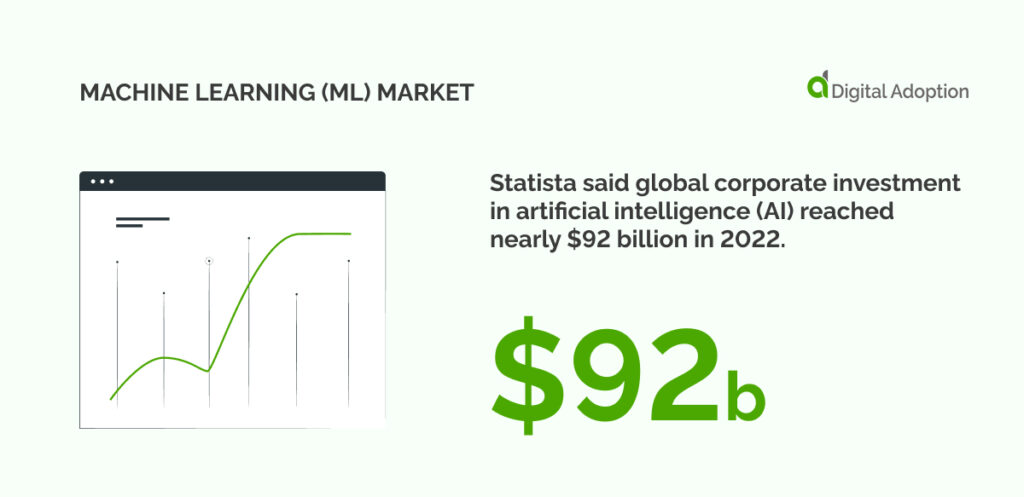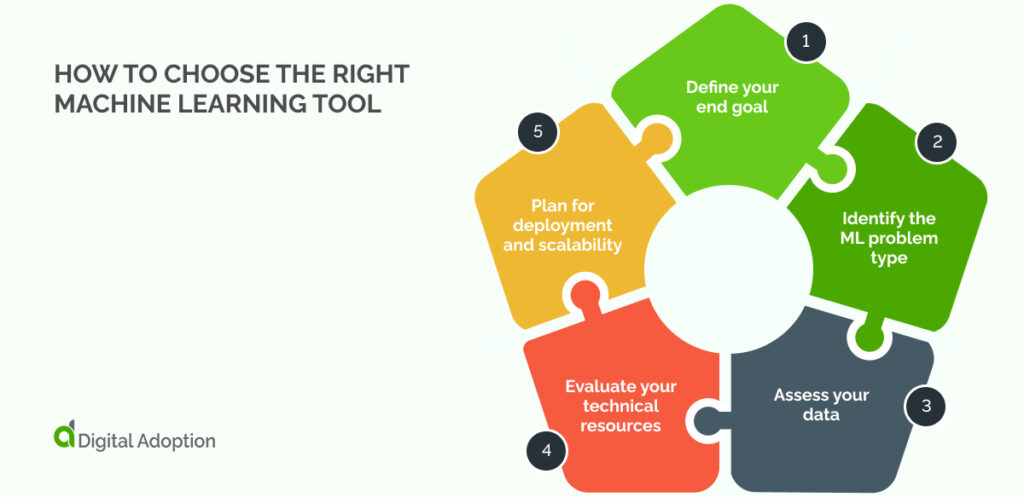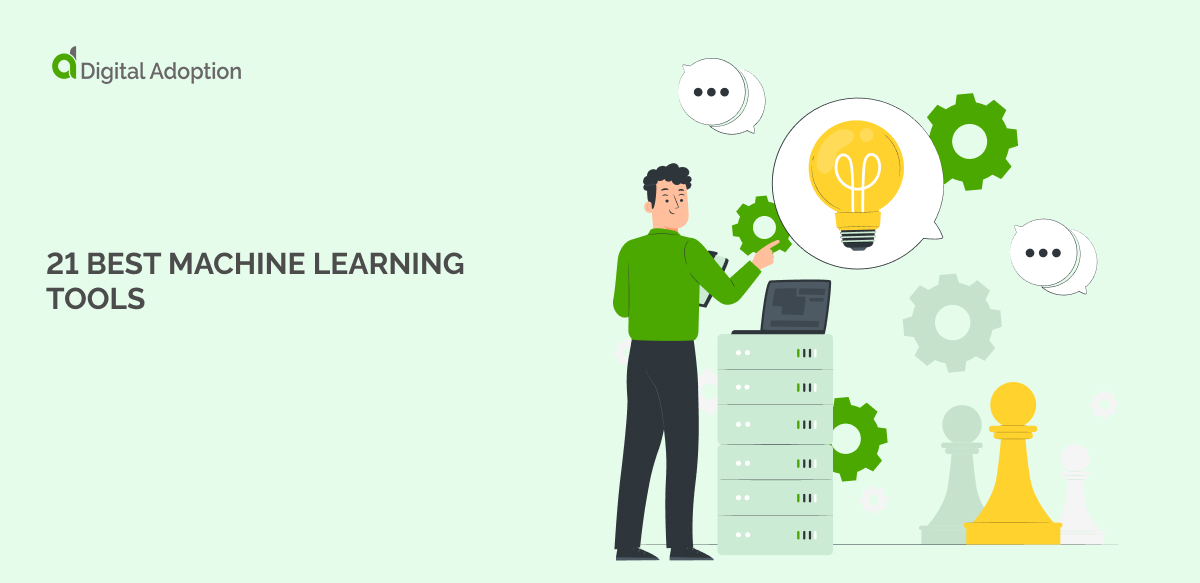Years of research and development in data and computer sciences are enabling more sophisticated AI technologies. From Alan Turing to John McCarthy, these strides are possible through the hard work and dedication of many throughout history.
Today, AI’s power continues to influence business and wider society. Teaching computers to perform intelligent tasks and learn without programming is a common goal among AI scientists and researchers worldwide.
Within AI, there are various subsets, each dedicated to developing specific types of AI for handling different tasks. For example, natural language understanding (NLU) focuses on understanding human language, and machine learning (ML) is about training computers to learn from data and self-improve.
This article will provide an overview of 21 best-of-class ML tools available today. We’ll also explore how to choose the right machine-learning tool to make informed decisions and leverage the capabilities of these tools for your specific needs.
What are machine learning tools?
Machine learning (ML) tools are resources that enable computers to learn from data and build intelligent systems. These tools help create ML models to execute actions, make targeted decisions, and iterate systems through training data.
Various types of ML tools are designed to address specific problems. For example, some ML may be aimed at developing either supervised or unsupervised systems. Others could remedy issues of classification or regression, allowing data scientists to tackle a wide range of challenges, from image recognition to stock market predictions.

Statista said global corporate investment in artificial intelligence (AI) reached nearly $92 billion in 2022. Investments in AI startups, in particular, almost doubled from 2020 to 2022. Notably, the top-funded AI companies are focused on machine learning and chatbots, aiming to improve human-machine interactions.
21 Best machine learning tools
Now we’ve explored what machine learning tools are, let’s delve into our list of the top ML tools that make waves industry-wide.
These best-of-class tools create cutting-edge solutions across various domains, showcasing their transformative impact on industries ranging from healthcare and finance to insurance and beyond.
- Microsoft Azure ML
Microsoft Azure ML is an ideal starting choice for businesses new to machine learning. Its drag-and-drop interface and pre-built modules make building and deploying models accessible.
The cloud-based platform eliminates the need to manage local hardware, allowing faster training and scalability. While some coding knowledge is helpful, Azure ML offers visual tools that reduce the need for intensive programming.
However, it may not be ideal for highly customized models requiring in-depth coding. Azure ML offers a user-friendly, cost-effective solution for businesses leveraging machine learning capabilities.
- Colab
Google’s Colab delivers GPU and CPU infrastructure for training ML models, reducing local setup needs.
Colab leverages Google’s cloud, where users can write and execute Python code in web-based environments. It facilitates cross-collaboration, allowing multiple users to simultaneously work on a single notebook.
Naturally, Colab integrates smoothly with G-Suite features like Drive, making storing and sharing projects easy. Its accessibility and smooth UI make it an ideal tool for data scientists, researchers, and educators alike.
- IBM Watson
- G2 rating: 4.2 (162 reviews)
- Pricing: Long-term license, As-a-service subscription, Free 30-minute consultation
IBM Watson dramatically reduced development time with its suite of pre-trained AI services, securing a well-deserved spot on this list.
Watson’s capabilities include natural language processing, computer vision, and machine learning, all accessible via a friendly UI. Businesses leverage Watson to build AI-driven applications to understand and interact with human language.
Its watertight security features and compliance with industry standards ensure data protection, making it a good choice for enterprises that handle sensitive data.
- Google Cloud AutoML
- G2 rating: 4.1 (22 reviews)
- Pricing: The pay-as-you-go pricing model offers a limited amount of free usage per month (the exact amount varies by service)
Google Cloud AutoML closes the skills gap in machine learning for non-experts by automating the model training process. Users can upload their data, and AutoML handles the rest, from training to deployment. This tool is especially useful for creating custom machine-learning models tuned to specific business needs. Its integration with Google Cloud’s infrastructure ensures scalability and reliability.
Google Cloud AutoML offers various services for tasks like image recognition (Vision), text translation, and custom API development. This variety can make the pricing structure more complex, with costs depending on the specific service and usage. However, each AutoML service typically offers a free tier with limited usage.
- TensorFlow
- G2 rating: 4.5 (69 reviews)
- Pricing: Open-source, download for free. ML projects may leverage various other sources that incur additional costs
TensorFlow is gaining attention for its versatility and extensive support for neural networks. Another ML developed by Google, this open-source library is widely used for both research and production environments.
TensorFlow’s robust ecosystem includes model building, training, and deployment tools, making it ideal for diverse applications, from image recognition to natural language processing. Its strong community support and continuous updates ensure that users can access the latest advancements in AI tech.
- Scikit-learn
- G2 rating: 4.8 (59 reviews)
- Pricing: Scikit-learn is an open-source library distributed under a BSD license. This means anyone can download, use, and modify the code for free without paying licensing fees.
Scikit-learn is an efficient and easy-to-use ML algorithm application library. This open-source Python library is popular among educators and data scientists.
Its well-documented API and comprehensive tools for data preprocessing, model selection, and evaluation streamline the development and testing of ML models. For instance, Scikit-learn’s robust support for cross-validation ensures accurate model performance assessment.
Its easy integration with other Python libraries like NumPy and Pandas enhances its flexibility, making it suited for both learning and professional projects.
- Amazon ML on AWS
- G2 rating: 4.4 (17,064 reviews)
- Pricing: Custom
Amazon ML simplifies the process of building and deploying predictive models with its easy-to-use UI and integration with Amazon Web Services (AWS).
Amazon’s ML service allows users to create models without needing deep expertise in algorithms or managing infrastructure. It can detect patterns in user data to make predictions and create highly accurate models.
Its scalability and reliability make it a practical choice for businesses hoping to integrate machine learning into their operations. Its compatibility with AWS services also lends to better data handling and deployment.
- OpenNN
- G2 rating: 4.9 (10 reviews)
- Pricing: OpenNN is an open-source project. The code itself is free to download and use.
OpenNN facilitates speed and efficiency through its high-performance library of neural networks.
It’s an open-source tool perfect for advanced analytics and deep learning. It’s designed to handle large datasets effortlessly and excels in numerical optimization for complex machine-learning tasks. For example, input data is processed to generate real-time predictive capabilities in the healthcare, energy, and marketing sectors.
The extensive documentation and multi-platform support make OpenNN a go-to for researchers and developers seeking reliable real-world ML solutions.
- Shogun
- G2 rating: 4.6 (58 reviews)
- Pricing: Shogun is a free and open-source software library. Its source code is publicly available, allowing anyone to inspect, modify, and contribute to its development.
Shogun’s focus on large-scale learning enables the development of strong machine-learning algorithms.
It’s another open-source library that supports a wide range of languages, including C++, Python, and R. Shogun offers an extensive collection of algorithms for classification, regression, and clustering, along with its efficient data handling capabilities.
This makes it a highly versatile tool for academic research and industrial applications. Its active community ensures ongoing improvements and updates.
- PyTorch
- G2 rating: 4.6 (20 reviews)
- Pricing: PyTorch is open source. This means the core library is free to download and use for any purpose, including commercial projects. There are no licensing fees associated with PyTorch.
PyTorch is highly regarded for its dynamic computational graph, which facilitates intuitive model building and debugging.
Developed by Facebook’s AI Research lab, this open-source library is extensively used in academic research and business projects. PyTorch’s seamless integration with Python and its support for GPU acceleration make it a preferred choice for deep learning applications.
Its strong community support and comprehensive tutorials enable users to quickly develop and deploy complex neural networks.
- XGBoost
- G2 rating: 4.4 (17 reviews)
- Pricing: Open Source and free to use.
XGBoost is known for its high performance and speed—particularly in handling structured data.
Another open-source library, XGBoost, implements gradient boosting algorithms that deliver state-of-the-art results in machine learning competitions. XGBoost’s scalability and efficiency in handling large datasets make it a top choice for data scientists and analysts. Its integration with various programming languages and platforms, along with its customizable parameters, provides users with the flexibility to fine-tune their models.
- Vertex AI
- G2 rating: 4.4 (421 reviews)
- Pricing: Pay as you go
Vertex AI simplifies the process of building, training, and deploying machine learning models on Google Cloud. This unified platform integrates various AI tools and services, allowing users to manage their ML workflows efficiently.
Vertex AI’s autoML capabilities and support for custom model training cater to both beginners and experienced ML practitioners. Its water-tight infrastructure ensures scalability and reliability, making it an ideal choice for enterprises seeking to implement AI solutions.
- Anaconda
- G2 rating: 4.6 (126 reviews)
- Pricing: Custom
Anaconda is a comprehensive distribution of Python and R for scientific computing, offering over 1,500 packages for data science. It simplifies package management and deployment, making it easier for data scientists to create and share environments.
Anaconda’s integrated development environment (IDE) and Jupyter Notebooks accelerate data analysis, visualization, and machine learning in genomics research. Extensive bioinformatics libraries empower researchers to tackle large-scale data, visualize variations, and build personalized medicine models. Its efficient handling of complex data pipelines makes Anaconda a valuable asset for advancing genomics and precision medicine.
- BigML
- G2 rating: 4.7 (24 reviews)
- Pricing: Standard, Boosted, Pro
BigML streamlines machine learning for researchers. This cloud platform offers a diverse algorithm toolbox with a drag-and-drop visual interface.
It empowers in-depth data exploration via visualization tools, aiding in pattern recognition crucial for model evaluation. BigML’s ability to handle large amounts of data is suited to fields like climate science, where researchers analyze environmental data to predict future trends.
- Apache Mahout
- G2 rating: 4.2 (13 reviews)
- Pricing: Free
Apache Mahout is designed to build scalable machine-learning applications. It’s free to use and offers a variety of algorithms for clustering, classification, and collaborative filtering. This open-source library leverages Apache Hadoop’s distributed computing capabilities to handle large datasets efficiently.
Mahout’s integration with big data ecosystems and its focus on scalability make it suitable for enterprise-level machine learning projects. Neuroscientists may use Mahout to analyze brain activity data. By applying clustering algorithms, they can identify distinct groups with unique patterns. This could potentially lead to breakthroughs in understanding brain function.
- Weka
- G2 rating: 4.3 (13 reviews)
- Pricing: Custom
Weka stands out for its easy-to-use graphical interface and comprehensive collection of machine-learning algorithms. This open-source software provides data preprocessing, classification, regression, clustering, and visualization tools.
Weka’s intuitive design and extensive documentation make it a popular choice for educational purposes and rapid prototyping. Its ability to work with various data formats and integration with other tools enhance its versatility.
- Accord.Net
- G2 rating: 4.9 (11 reviews)
- Pricing: Custom/Licence
Accord.Net is a .NET machine learning framework that provides various statistical and machine learning algorithms. This open-source library supports image processing, computer vision, and audio analysis, making it suitable for a variety of applications.
Accord.Net’s extensive documentation and examples help developers quickly implement and deploy machine learning solutions. Its integration with the .NET ecosystem ensures compatibility and ease of use for Windows-based applications.
- Keras
- G2 rating: 4.6 (64 reviews)
- Pricing: Open source
Keras is a high-level neural network API that runs on top of TensorFlow, simplifying the building and training of deep learning models. This open-source library is known for its user-friendly interface and modular design, allowing quick prototyping and experimentation.
Keras’s compatibility with TensorFlow ensures access to powerful computational resources and advanced functionalities. Its extensive documentation and strong community support make it accessible to beginners and experts.
- Amazon SageMaker
- G2 rating: 4.2 (37 reviews)
- Pricing: Custom
Amazon SageMaker streamlines the process of building, training, and deploying machine learning models at scale. This fully managed service integrates with Amazon Web Services (AWS) to provide a comprehensive environment for machine learning development.
SageMaker’s built-in algorithms, customizable training jobs, and easy deployment options make it a powerful tool for businesses looking to implement ML solutions quickly. Its scalability and security features ensure reliable performance for enterprise applications.
- Saturn Cloud
- G2 rating: 4.9 (267 reviews)
- Pricing: Custom
Saturn Cloud is an award-winning machine learning (ML) platform designed to make developing and using AI, ML, and large language models (LLMs) secure and straightforward for businesses. This cloud-based platform is an all-in-one solution encompassing data science, machine learning development, deployment, and data pipelines.
Within Saturn Cloud, users can leverage high-powered resources, including spinning up notebooks with massive amounts of RAM (up to 4TB) and adding GPUs for tackling demanding tasks. The platform also facilitates distributed computing by connecting users to a distributed cluster of workers.
- KNIME Analytics Platform
The KNIME Analytics Platform excels in complex data integration and analysis. Its node-based workflow editor allows users to construct data processing and machine learning pipelines without coding visually.
For example, KNIME can integrate disparate data sources such as SQL databases, Excel files, and web APIs into a single workflow. It also supports advanced analytics tasks like predictive maintenance by incorporating machine learning models directly into the pipeline. This flexibility is crucial for businesses needing comprehensive data analysis and configurations with other tools.
How to choose the right machine learning tool

Choosing the right machine learning tool requires determining which pain points need to be addressed most. Answering a few basic questions will help you narrow down the best tool for the job.
These could include asking:
- What is the end goal we are trying to achieve?
- What type of machine learning problem are we solving?
- What kind of data do we have available?
- What are our technical resources and expertise?
- What are the deployment and scalability requirements?
With these questions answered, selecting the perfect machine learning (ML) tool for your project involves carefully considering several key factors.
Define your end goal
The first step is clearly defining the problem you’re trying to solve or the task you want to automate.
What is the desired outcome of your machine learning project? Are you aiming to improve customer churn prediction, automate image recognition, or generate more accurate sales forecasts?
A clear understanding of your end goal will guide your choices throughout the entire ML tool selection process.
Identify the machine learning problem type
Machine learning tackles a wide range of tasks, each requiring specific approaches. Once you know your end goal, identify the type of machine learning problem you face. There are three common types of machine learning: classification, regression, and clustering.
Classification sorts data points into predefined categories, while regression predicts continuous values. Clustering groups similar data points to uncover patterns. Understanding the type of problem you’re solving will help you narrow down the field of suitable ML tools.
Assess your data
The quality and characteristics of your data are crucial for choosing the right ML tool. When selecting a machine-learning tool, consider your data’s size and format. Some methods handle massive datasets, while others work best with smaller samples. You’ll also need to determine if your data is structured, like tables in a spreadsheet, or unstructured, like text or images.
Ensure the tool you choose is compatible with your data format. Evaluate data quality—is your data clean and accurate? Some tools require minimal data cleaning, while others offer built-in features to address data quality issues. For supervised learning tasks, determine if your data is already labeled or if labeling will be required, as this can impact tool selection.
Evaluate your technical resources
The technical expertise of your team is another critical factor. Consider what programming languages and frameworks your team is familiar with, as some ML tools may have specific language or framework requirements and learning curves.
Assess your team’s development experience with machine learning models—prior expertise can influence the level of user-friendliness and support needed from the chosen tool. Selecting a tool that aligns with your team’s skill set can streamline development and ensure efficient utilization of the tool’s functionalities.
Plan for deployment and scalability
Finally, consider the practical aspects of deploying and scaling your ML model. Consider where you’ll deploy it—on your own servers, a cloud platform, or even mobile devices. Make sure the chosen tool works with your chosen deployment environment.
Evaluate scalability and determine how much data the model will need to handle in the future. Choose a tool that can scale efficiently as your data volume and processing needs grow. Planning for deployment and scalability from the outset ensures your chosen ML tool can meet your project’s requirements now and in the future.
Mastering machine learning tools
With an arsenal of machine learning tools at your disposal, selecting the perfect one can be a daunting task.
You can make an informed decision by clearly defining your goals, understanding the type of problem you face, and carefully assessing your data, resources, and deployment needs.
Remember, the ideal tool seamlessly integrates with your workflow, empowers your team’s expertise, and scales to meet your project’s ever-growing demands.
With these key factors in mind, you’ll be well on your way to harnessing machine learning’s potential for groundbreaking results.









